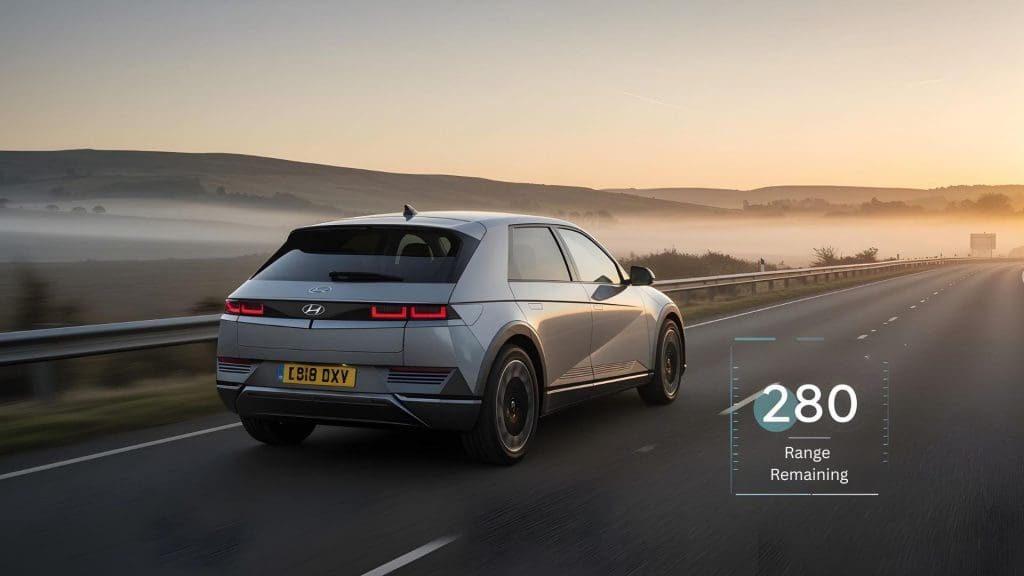For years, it was the ghost at the feast of every electric vehicle discussion. The number one question on the lips of any potential convert: “But what about the range?” This fear, dubbed “range anxiety,” painted a terrifying picture of families stranded on the hard shoulder of the M6 on a rainy Tuesday, battery at a flat zero. Let’s be clear: in 2025, that fear is a relic. For the vast majority of UK drivers, range anxiety is no longer a legitimate concern but a myth perpetuated from the early days of EVs. The combination of huge leaps in battery technology and a rapidly expanding charging network has transformed the landscape. Today, the conversation isn’t about anxiety; it’s about awareness. It’s about understanding your car, just as you’d understand how much petrol is in the tank. Here’s the real-world picture.
The Numbers Don’t Lie: Real‑World Range in the UK
First, it’s important to distinguish between the “official” range and the “real-world” range. The official figure you see in brochures is the WLTP (Worldwide Harmonised Light Vehicle Test Procedure) range, which is achieved in controlled lab conditions. Real-world driving—with its traffic, hills, and British weather—is always a bit different. However, even with that in mind, the real-world range of most 2025-era EVs is more than enough for what the average UK driver needs. Here’s a look at some popular models on our roads today and what you can realistically expect from them in normal, mixed driving conditions.:
| Model | WLTP Range | Real‑World (Summer) |
|---|---|---|
| Tesla Model 3 Long Range | 390 mi | ≈ 340 mi |
| Kia EV6 (77 kWh) | 328 mi | ≈ 280 mi |
| MG4 EV Long Range | 281 mi | ≈ 245 mi |
| Polestar 2 Long Range | 367 mi | ≈ 320 mi |
| Renault 5 E‑Tech (52 kWh) | 249 mi | ≈ 215 mi |
The London‑to‑Manchester Test
That 210-mile trip from London to Manchester? All the EVs above can do it in one go—with margin to spare. Even the Renault 5. A Tesla or Polestar would arrive with over 100 miles left on the battery.
You need not fear planning stops—just stop for a coffee and shower, and let 150 kW+ rapid charging give your car another 100–150 miles.
Factors That Influence Range (and How to Manage Them)
UK Winter Weather
Cold weather can reduce range by up to 30%. Batteries are less efficient and the cabin heater draws power.
Tip: Pre‑heat while still plugged in using a smart tariff—heat seats not air, and rely on cabin insulation.
Speed & Driving Style
Driving fast on motorways drains battery quickly due to air resistance. Regenerative braking (a.k.a. one‑pedal driving) helps recover energy in slower zones.
Tip: Cruise at 50–60 mph when possible, coast smoothly, and use regen—your EV rewards you with extra miles.
London, Norwich, Birmingham & Beyond
Across cities from London to Glasgow, Sheffield to Cork, public charging infrastructure now supports motorists reliably. Apps like ONEEV let you plan routes, view live charger availability, compare prices, and book stations in real time.
Even in smaller towns like Leicester, Stevenage, or Burnley you’ll typically find multiple 150+kW hubs along major roads.
Charging Stops: Not Anxiety, But Awareness
In 2025, long drive stops are no longer panic moments—they’re natural breaks. With ultra-rapid chargers, you get roughly 100 miles added while making a coffee or stretching your legs.
Modern EVs average 250–350 mpg real-world on a single charge if driven responsibly—making roadside panic less relevant.
Final Word: From Anxiety to Awareness
Range anxiety hovers in history now. What you need isn’t fear—it’s range awareness. Know your car, check the chargers, and use apps like ONEEV to monitor your usage, plan smart routes, and keep awareness active—not worry.
